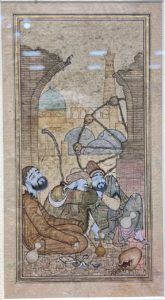THREE DERVISHES
“THREE DERVISHES”. 2016 год.
Artist: Shorasul Shoakhmedov

Shorasul Shoakhmedov is a prominent representative of modern miniature art, participant of republican and foreign exhibitions. The winner of the republican stage of the “Tashabbus-2022” review competition, in which he was awarded a gold medal. One of his miniatures is dedicated to dervishes.
Dervish, qalandar, poor man, beggar, fakir – a person who wholly devoted himself to serving God and embarked on the path of self-improvement, any member of a Ṣūfī (Muslim mystic) fraternity. The meaning of the word “dervish” is similar to the Sufi philosophy of voluntary and conscious poverty, renunciation of the world and all its pleasures and contentment with little. Dervishes united in Sufi brotherhoods – suluks and preached the ideas and traditions of these communities. The Kubrawiyya, Naqshbandiya and Yasawiyya Sufi orders appeared in Central Asia.
The composition depicts three dervish figures seated under the ruined wall. Two of them sit in an intoxicated state with their eyes closed, leaning against each other. One of the qalandars holds a staff wrapped with a thin rope, one of the main attributes of the dervishes, which had magical properties. The third dervish is depicted at the foot of the destroyed wall in a state of religious ecstasy.
All three dervishes are dressed in the traditional qalandars clothing – khirkah – a holey or patched robe. These numerous patches were sewn on as a symbol of “spiritual poverty.” Some sources mention that such khirkas were sewn from the shreds of Sufis’ clothes, who tore them in a state of religious ecstasy, thus, this attribute of the dervish had a sacred energetic meaning. On the head of one of the qalandars a cone-shaped furry kulakh cap is worn, which was an integral part of the wandering dervish costume. The heads of two other dervishes are also covered with headdresses: one has a turban, the other has a well-worn skullcap.
Next to the male figures, there is a gourd water bottle – a necessary attribute of wandering dervish, in the center of the lower part of the composition there is a chilim smoking pipe. Next to it, a chirag oil lamp, an inkpot and two books: one closed, the other opened and turned upside down are visible. In the lower right corner there is a broken jug with gold coins, symbolizing the fragility of the mortal world and indifference of fakirs to the earthly possessions.Behind the dervishes is a symbolic image of chigir, a watermill, representing the “wheel of life”.The architectural objects of ancient Bukhara are used in a background, which indicates that the dervishes belong to the Naqshbandiya Sufi order.The color solution of the composition is based on a harmonious combination of cold and warm tones – gray-blue and ochre-brown.
КК-1017